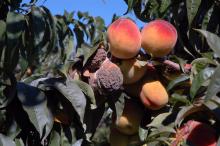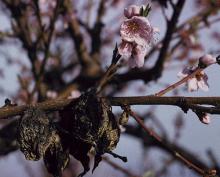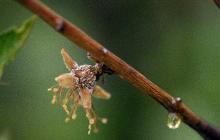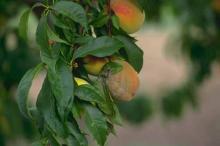Cause The fungi Monilinia fructicola and M. laxa can incite both a blossom blight, a twig and branch dieback, and a fruit rot of several Prunus spp. including many ornamental and fruit trees. Fungi survive year to year on infected twigs, branches, old flower parts, or mummified fruit. Conidia are produced on infected plant debris in the tree when the temperature is above 40°F. A small, mushroom-like structure (apothecium) can be produced on fruit that drops to the ground. Wind and rain blow spores (conidia and ascospores) to healthy blossoms in spring to begin the infection process during wet weather. Infection will occur for M. laxa above 55°F. Infection may occur at any temperature above freezing with 24 hours wetness. Flowers can be blighted any time floral tissue is exposed but are most susceptible at full bloom. More spores can be produced on this tissue, initiating several more disease cycles during the spring.
Some infections may be symptomless until fruit begins to ripen. Ripening fruit also is highly susceptible to infection, and many more disease cycles can occur near harvest. Peach and nectarine fruit that fall to the ground due to lack of pollination, thinning, or over-ripeness can significantly increase inoculum and the amount of fruit rot at harvest. Fruit infected in the orchard may not show symptoms until it is in storage or in transit. High nitrogen fertilization also is associated with increased levels of brown rot.
Both fruiting and ornamental cherries, peaches, nectarines, prunes, plums, almonds, and apricots are susceptible. The disease is more a problem west of the Cascade Range. Surveys of eastern Washington packinghouses during 2000 and 2001 found very little brown rot on peaches and nectarines.
Symptoms Infected flower parts turn light brown and may develop areas of buff-color (M. fructicola) or gray (M. laxa) spores. Infected petals may look water soaked, which can be mistaken for frost injury. Flowers generally collapse as the fungus invades through the pedicel. Infected flowers often adhere to twigs and spurs through harvest or even winter. On peach, the disease continues into twigs or spurs. Lesions may remain discrete or may girdle the twig, causing all distal portions to die. Profuse gumming also may be in these areas. Again, buff or gray spores (in sporodochia) may develop on these necrotic twigs.
Fruit symptoms begin as small, dark spots that enlarge rapidly. Fruit remains fairly firm and dry relative to a watery rot caused by Rhizopus sp. Production of masses of buff-colored spores is equally rapid in the necrotic area. Peaches may have concentric rings of gray sporulation as the rot takes a few days to encompass the entire fruit.
Cultural control These must be supplemented by chemical control methods especially in the wettest areas such as west of the Cascade Range.
- Remove and destroy infected twigs and branches in summer.
- Remove and destroy all mummified fruit in and around the tree. Cultivating or burying old fruit before the growing season will not reduce the risk of this disease. However, removing fallen fruit (due to thinning or lack of pollination) can significantly reduce the amount of rot at harvest.
- Control insects that could wound and injure fruit.
- Avoid wounding fruit during harvest.
- Cool fruit rapidly after harvest.
- Use moderate amounts of nitrogen fertilizer.
- A short (2.5 min) soak in hot water (122°F) has reduced postharvest decay in nectarines and peaches. Some additives have increased efficacy of this treatment.
Chemical control Apply fungicides during the blossoming period at early pink bud, full bloom, and/or petal fall to control the blossom blight phase. In California, one or two sprays are sufficient most years if a product with systemic (translaminar) activity is used. Fruit rot sprays can be applied before harvest if wet weather is expected. Tank-mix and/or alternate products with different modes of action to prevent the build-up of resistant fungi. Limit the use of any one group during crop production. Selection of products for rotation and/or mixing must consider group 7 fungicides when used through the irrigation as a nematicide.
- Abound at 12 to 15.5 fl oz/A. Do not apply with silicone-based surfactants. May be applied the day of harvest. Sprayers used for Abound should not be used on apples. Group 11 fungicide. 4-hr reentry.
- Bonide Captan 50 WP may be used in home gardens at 1 to 1.5 Tbsp/gal water. Washington only. H
- Bravo Weather Stik at 3.1 to 4.1 pints/A. Do not apply after shuck split. Avoid use when honey bees are active due to larval toxicity. Group M5 fungicide.12-hr reentry.
- Captan 80 WDG at 2.5 to 5 lb/A. Applications may be made day of harvest. Fair to good control. Avoid use when honey bees are active due to larval toxicity. Group M4 fungicide. 24-hr reentry.
- Cevya at 3 to 5 fl oz/A. May be used day of harvest. Group 3 fungicide. 12-hr reentry.
- Cinnerate at 16 to 64 fl oz/100 gal water plus an adjuvant. 4-hr reentry. O
- Eagle 20 EW at 2 to 3 fl oz/100 gal water for home orchards or landscape use. Can be applied up to the day of harvest. Group 3 fungicide. 24-hr reentry.
- Echo 720 at 3.1 to 4.1 pints/A, for blossom blight only. Do not apply after shuck split. Avoid use when honey bees are active due to larval toxicity. Group M5 fungicide. 12-hr reentry.
- EcoSwing at 1.5 to 2 pints/A. Can be used day of harvest. Fair control. Group BM01 fungicide. 4-hr reentry. O
- Elevate 50 WDG at 1 to 1.5 lb/A. Can be applied up to and including the day of harvest. Group 17 fungicide. 12-hr reentry.
- Fontelis at 14 to 20 fl oz/A. Can be used day of harvest. Group 7 fungicide. 12-hr reentry.
- Indar 2F at 6 fl oz/A plus a wetting agent. Group 3 fungicide. 12-hr reentry.
- Inspire Super at 16 to 20 fl oz/A. Do not apply within 2 days of harvest. Group 3 + 9 fungicide. 12-hr reentry.
- Iprodione-based products. Do not apply after petal fall. Generally good control if resistance is not a problem. Do not mix with insecticides due to honey bee adult and/or larval toxicity. Group 2 fungicides. 24-hr reentry.
- Iprodione 4L AG at 1 to 2 pints/A.
- Meteor at 1 to 2 pints/A.
- Rovral 4 Flowable at 1 to 2 pints/A.
- Kenja 400 SC at 12.5 fl oz/A. Do not use within 1 days of harvest. Group 7 fungicide. 12-hr reentry.
- Luna Experience at 6 to 10 fl oz/A. May be used day of harvest. Group 3 + 7 fungicide. 12-hr reentry.
- Luna Sensation at 5 to 7.6 fl oz/A. Do not use within 1 day of harvest. Group 7 + 11 fungicide. 12-hr reentry.
- Merivon at 4 to 6.7 fl oz/A. Do not use with EC or oil-based products. Only nonionic surfactants can be used within 14 days of harvest. May be used day of harvest. Group 7 and 11 fungicide. 12-hr reentry.
- Microthiol Disperss (80% sulfur) at 10 to 20 lb/A. Do not use a spreader-sticker. Only slight control; not recommended for use during bloom. 24-hr reentry.
- Miravis at 5.1 fl oz/A. Can be used up to the day of harvest. Group 7 fungicide. 12-hr reentry.
- Miravis Duo at 13.6 fl oz/A. Can be used up to the day of harvest. Group 3 + 7 fungicide. 12-hr reentry.
- Oso SC at 6.5 to 13 fl oz/A. May be applied on the day of harvest. Group 19 fungicide. 4-hr reentry. O
- Pristine at 10.5 to 14.5 oz/A. Can be used day of harvest. Group 7 + 11 fungicide. 12-hr reentry.
- Problad Verde at 18.1 to 45.7 fl oz/A. Reapply if rain occurs within 12 hours of original application. Do not use within one day of harvest. Group BM01 fungicide. 4-hr reentry.
- Propiconazole-based fungicides are registered. Limited to two (2) applications. Do not mix with insecticides due to bee toxicity. Group 3 fungicides.
- Bumper 41.8 EC at 4 oz/A. May be used up to and including day of harvest. 12-hr reentry.
- Infuse Systemic Disease Control at 2 Tbsp/gal water. H
- PropiMax EC at 4 fl oz/A. Do not use within 10 days of harvest. 12-hr reentry.
- Tilt at 4 oz/A. May be used up to and including day of harvest. 24-hr reentry.
- Quadris at 12 to 15.5 fl oz/A. May be applied the day of harvest. Sprayers used for Abound should not be used on apples. Group 11 fungicide. 4-hr reentry.
- Quadris Top at 12 to 14 fl oz/A. May be applied on the day of harvest. Do not mix with insecticides due to bee toxicity. Group 3 + 11 fungicide. 12-hr reentry.
- Quash at 2.5 to 4 oz/A. Do not use within 14 days of harvest. Group 3 fungicide. 12-hr reentry.
- QuiltXcel at 14 fl oz/A. May be applied the day of harvest. Sprayers should not be used on apples. Group 3 + 11 fungicide. 12-hr reentry.
- Rally 40 WSP at 2.5 to 6 oz/A. Can be applied up to the day of harvest. Not as good as the manufacturer's other Group 3 fungicide, Indar. Group 3 fungicide. 24-hr reentry.
- Rhyme at 7 fl oz/A. Do not use within 7 days of harvest. Group 3 fungicide. 12-hr reentry.
- Scala SC at 9 to 18 fl oz/A. Do not apply within 2 days of harvest. Not for cherry-only for apricot, peach, prune and plum. Group 9 fungicide. 12-hr reentry.
- Spectracide Immunox Multi-Purpose Fungicide Spray Concentrate for Gardens at 0.5 fl oz/gal water. May be applied up to the day of harvest. Do not use more than seven (7) times per season. Group 3 fungicide. H
- Sulfur-based products have good efficacy during bloom for blossom blight control but are not as useful for fruit rot. Do not use within 2 weeks of an oil spray. Group M2 fungicides. 24-hr reentry. O
- Bonide Sulfur Plant Fungicide (90% wettable) at 1 to 3 Tbsp/gal water. H
- Microthiol Disperss (80% sulfur) at 10 to 20 lb/A. Do not use a spreader-sticker.
- Thiolux (80% sulfur) at 10 to 30 lb/A.
- Tebucon 45 DF at 4 to 8 oz/A. Can be applied up to and including day of harvest. Generally good to excellent control. Group 3 fungicide. 5-day reentry.
- Tesaris at 3.5 to 5.6 fl oz/A. Do not use with oil-based products. May be used day of harvest. Group 7 fungicide. 12-hr reentry.
- Thiram Granuflo at 3.5 lb/A. Do not apply within 7 days of harvest. Also serves as an animal repellent. 24-hr reentry.
- Topguard SC at 14 fl oz/A. Do not use within 7 days of harvest. Group 3 fungicide. 12-hr reentry.
- Topguard EQ at 6 to 8 fl oz/A. Do not use with silicone surfactants or within 7 days of harvest. Sprayers should not be used on apples. Group 3 + 11 fungicide. 12-hr reentry.
- Topsin 4.5 FL at 20 to 30 fl oz/A plus another fungicide with good protection activity. Do not apply within 1 day of harvest. Group 1 fungicide. 2-day reentry.
- Vangard 75 WG at 5 oz/A plus another fungicide. For blossom blight only. Do not use with X-77. Group 9 fungicide. 12-hr reentry.
- Ziram 76 DF at 6 lb/A. Do not apply within 30 days of harvest. Generally, gives slight control. Avoid use when honey bees are active due to larval toxicity. Group M3 fungicide. 48-hr reentry.
Notes: Fixed-copper products are registered but due to low level of control are not recommended.
Some registered products offer only suppression of this disease and thus are not recommended for use. These products include Dodine Flint Extra and Syllit.
Biological control
- Botector (Aureobasidium pullulans strains DSM 14940 and 14941) at 6 to 14 oz/A depending on water volume. Can be applied day of harvest. Compatible with sulfurs, oils and a few fungicides but not with many synthetic fungicides. 4-hr reentry. O
- BotryStop (Urocladium oudemansii U3 strain) at 2 to 4 lb/A. Keep refrigerated before use. Compatible with many wetting agents, some fungicides and biologicals, but not all. Unknown efficacy in the PNW. 4-hr reentry. O
- DoubleNickel 55 (Bacillus amyloliquefaciens strain D747) at 0.25 to 3 lb/A. Unknown efficacy. Not recommended for fruit rot control. Group BM02 fungicide. 4-hr reentry. O
- Howler Evo (Pseudomonas chlororaphis strain AFS009) at 20 to 120 oz /A plus a surfactant. Can be used day of harvest. 4-hr reentry. O
- Serenade OPTI (Bacillus subtilis strain QST 713) at 14 to 20 oz /A. Active ingredient is a small protein. Use only for blossom blight during bloom. 4-hr reentry. O
- Serenade Garden Disease Control Concentrate at 2 to 4 fl oz/gal water. Use only for blossom blight during bloom. H O
References Lalancette, N., Blaus, L. L., and Engel, P. 2020. Refinement of Peach Cover Spray Programs for Management of Brown Rot at Harvest. Plant Disease 104:1527-1533.
Villarino, M., Melgarejo, P., Usall, J., Segarra, J., and De Cal, A. 2010. Primary inoculum sources of Monilinia spp. in Spanish peach orchards and their relative importance in brown rot. Plant Disease 94:1048-1054.






